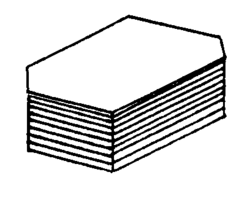Vermiculite

Contents
Background
Vermiculite is a mineral that belongs to a group of minerals called the mica minerals. The mica group of minerals includes: biotite, muscovite, lepidolite, and phlogopite. Vermiculite is formed by the alteration and/or weathering of the minerals biotite and phlogopite. All mica minerals break into very thin sheets. Mineralogists call this micaceous cleavage. Like the mineral talc, vermiculite has layers of water sandwiched in between layers of silicate. Consequently, when vermiculite is heated, the water is driven off and the mineral expands. This expanded and lighter form of vermiculite is used extensively in industry, agriculture and construction.
Name
The name vermiculite was created from the Latin word for worm, vermiculus. This is a reference to the fact that when vermiculite is heated, it expands into wormlike shapes.
Sources
Two companies with three operations in the United States, two in South Carolina and one in Virginia, mine vermiculite. Other deposits occur in Texas, Colorado, Nevada, North Carolina, and Wyoming.
Vermiculite is imported into the United States primarily from two countries: The majority of the imported vermiculite comes from South Africa; with a smaller amount coming from China. Other countries producing vermiculite include Russia, Australia, Zimbabwe, Brazil and [Japan]].
Uses
Vermiculite is used in a number of different applications. The majority of vermiculite is used annually for agriculture and insulation purposes. In agriculture it is used in horticulture and mixed with soil to create a more porous, absorbent soil. As an insulator, it is used both as a heat and sound insulating material. Vermiculite is added to concrete mixtures to create a lightweight concrete mix.
Substitutes and Alternative Sources
Several materials can be used in place of vermiculite for various applications. Expanded perlite can be used to make lightweight concrete. (Perlite is a form of volcanic glass, similar to obsidian. Unlike obsidian, it has a high water content, so that when it is heated, it expands and becomes much lighter.) Shale, slate and clay can be used as well; however, they are less expensive but considerably heavier than perlite and vermiculite. Fiberglass, perlite and slag wool can be used for insulating purposes in place of vermiculite. A number of different plant materials (peat, saw dust, wood chips, leaves, and other organic materials) can be used to condition and prepare soil for plants and horticulture.
Further Reading
- Common Minerals and Their Uses, Mineral Information Institute.
- More than 170 Mineral Photographs, Mineral Information Institute.
| Disclaimer: This article is taken wholly from, or contains information that was originally published by, the Mineral Information Institute. Topic editors and authors for the Encyclopedia of Earth may have edited its content or added new information. The use of information from the Mineral Information Institute should not be construed as support for or endorsement by that organization for any new information added by EoE personnel, or for any editing of the original content. |